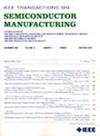Quantifying the Impact of Outdoor Airborne Nano-Contamination on eSiGe Defect Generation and Machine Learning-Based Predictive Modeling
IF 2.3
3区 工程技术
Q2 ENGINEERING, ELECTRICAL & ELECTRONIC
引用次数: 0
Abstract
A thorough investigation was conducted to determine the impact of outdoor airborne nanoparticles on defect generation during semiconductor manufacturing. Periods of elevated airborne particle levels, along with increased occurrences of embedded Silicon-Germanium (eSiGe) defects, were analyzed using experimental bare wafers designed to capture nanoparticles. Defect counts were analyzed to trace their origins. A novel data processing algorithm was developed to clarify and quantify the relationship between external airborne nanoparticles and defect formation. The findings indicate that eSiGe defect particles attributable to external airborne nano-contamination were generated at rates ranging from 1% to 6%, depending on the fab site. The robustness of the algorithm was validated through the application of an Artificial Neural Network (ANN) technique. Key parameters influencing eSiGe defects, identified as outdoor PM2.5 and Fab particles, were further analyzed using Random Forest Regression (RFG) and Quantile Regression (QR). Additionally, the application of Support Vector Regression (SVR) significantly enhanced the prediction accuracy of eSiGe defect particles, achieving an improvement of approximately 56% compared to RFG modeling. This study uniquely combines short-term experimental methods with long-term inline data science techniques to elucidate the effects of outdoor nanoparticles on eSiGe defects.室外空气纳米污染对eSiGe缺陷产生的量化影响及基于机器学习的预测建模
为了确定室外空气中纳米颗粒对半导体制造过程中缺陷产生的影响,进行了一项深入的研究。利用设计用于捕获纳米颗粒的实验性裸晶圆,分析了空气中颗粒水平升高的时期,以及嵌入硅锗(eSiGe)缺陷发生率的增加。缺陷计数被分析以追踪它们的起源。开发了一种新的数据处理算法来澄清和量化外部空气中纳米颗粒与缺陷形成之间的关系。研究结果表明,由于外部空气中的纳米污染,eSiGe缺陷颗粒的产生率在1%到6%之间,这取决于晶圆厂的位置。通过应用人工神经网络技术验证了该算法的鲁棒性。影响eSiGe缺陷的关键参数,确定为室外PM2.5和Fab颗粒,进一步使用随机森林回归(RFG)和分位数回归(QR)进行分析。此外,支持向量回归(SVR)的应用显著提高了eSiGe缺陷粒子的预测精度,与RFG建模相比,提高了约56%。本研究独特地将短期实验方法与长期在线数据科学技术相结合,阐明了室外纳米颗粒对eSiGe缺陷的影响。
本文章由计算机程序翻译,如有差异,请以英文原文为准。
求助全文
约1分钟内获得全文
求助全文
来源期刊

IEEE Transactions on Semiconductor Manufacturing
工程技术-工程:电子与电气
CiteScore
5.20
自引率
11.10%
发文量
101
审稿时长
3.3 months
期刊介绍:
The IEEE Transactions on Semiconductor Manufacturing addresses the challenging problems of manufacturing complex microelectronic components, especially very large scale integrated circuits (VLSI). Manufacturing these products requires precision micropatterning, precise control of materials properties, ultraclean work environments, and complex interactions of chemical, physical, electrical and mechanical processes.
 求助内容:
求助内容: 应助结果提醒方式:
应助结果提醒方式:


